- Home
- Splitting Firewood
- Firewood Splitter
Firewood Splitter
This post may contain affiliate links so I earn a commission.
Using the correct firewood splitter for the job makes a huge difference in the amount of time and energy it takes you to split up a pile of wood.
Although I love heating with wood, one downside with firewood is the number of times you handle the wood as you convert a standing tree into a radiant warmth that will heat your entire home.
Those who have been heating with firewood know the old saying that firewood will heat you up multiple times between cutting, splitting, hauling and then finally burning the wood.
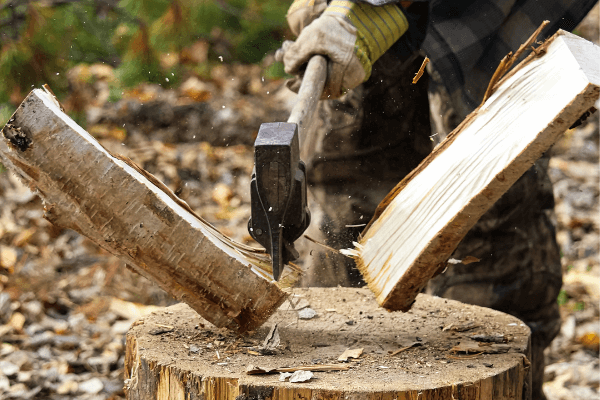
So, I'm always searching for the best tools on the market to make each step of the process a little bit easier.
Just like modern machinery and technology has changed every aspect of our lives, its also impacted the tools we have available to split firewood.
Large, heavy splitting mauls can now be replaced with lightweight splitting axes.
Splitting wedges that were once driven with a sledge hammer can be replaced with hydraulics powered by an efficient engine.
To learn more, let's compare some of the best tools that make splitting firewood a lot easier.
Firewood Splitter - Splitting Axe vs. Maul
Weighing 6, 8 and even 12 pounds, a splitting maul is a classic firewood splitter.
With its long straight handle and broad heavy head, the maul is designed the split the wood fibers apart without getting stuck in the log.

Although a maul works good for splitting firewood, the obvious downfall is its weight.
Sure, you can split a couple of pieces of wood without getting too winded, but if you need to split a face cord or more, the weight of a maul will wear you out.
Using a classic felling axe to split wood won't work because a felling axe is designed to cut the wood fibers, not split them apart.
This results in a felling axe getting stuck into the top of the log rather than splitting it into smaller pieces.
Using a splitting axe will change the way you split firewood.
A splitting axe is kind of like a cross between a felling axe and a maul.
The splitting axe is lightweight and the axe head is designed to split the fibers of the wood without getting stuck.
Two of my favorite splitting axes are the Fiskars x27 Supper Splitting Axe and the Hults Bruk Sarek.
The Fiskars x27 weighs under 6 pounds and has a long 36 inch handle that's perfect for taller users.
I don't like to split firewood with a short axe.
It makes me nervous because the head of the axe is too close to my legs and feet.
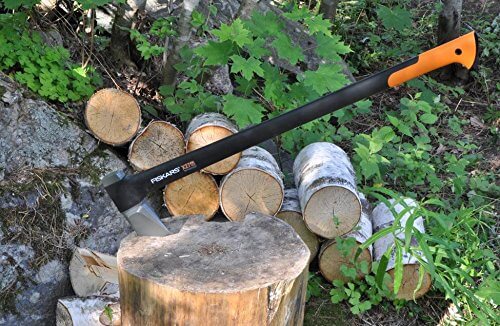
The long handle on the Fiskars keeps the axe away from my feet and also helps with leverage as you strike down on the wood.
I purchased my x27 about 10 years ago and my only regret is not buying one sooner.
I've let multiple people borrow the axe and everyone who's borrowed it has purchased one for themselves.
With one split strikes, the x27 is light enough to swing over and over, but powerful enough to split some of the toughest logs.
The plastic handle is strong and durable and the molded head design keeps the axe head firmly in place.
If you're looking for a great firewood splitter, I strongly suggest buying a x27 Super Splitter by Fiskars.
Another great splitting axe is the Hults Bruk Sarek.
Although it's a little shorter than the x27, it does a great job splitting wood.
The axe head is hand forged in Sweeden and its solid hickory handle makes the Sarek look as beautiful as it performs.
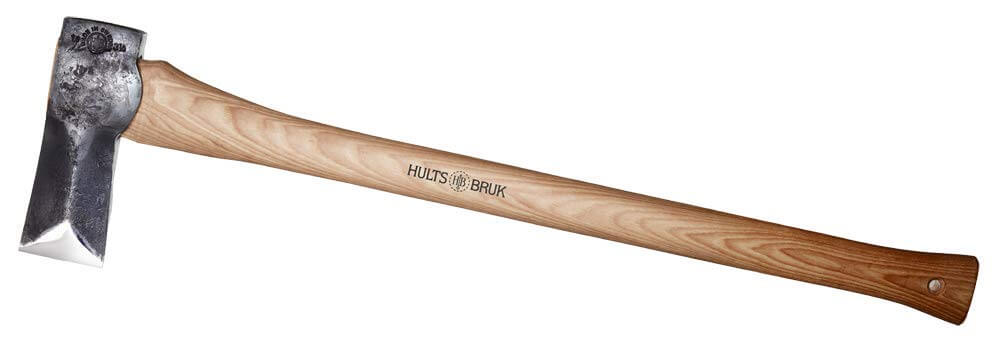
There's something special about the feel of an axe with a wooden handle compared to the plastic handle of the Fiskars.
Both perform amazingly in their own categories and it really just comes down to personal preference.
Use A Splitting Block
No matter which axe you choose, you should always split firewood on a splitting block.
A splitting block accomplishes a few things.
First, it elevates your firewood off the ground and prevents glancing blows from your axe.
Since the wood is elevated, the axe handle is close to a 90 degree angle to the top of the log when it strikes the wood.
This allows the splitting edge of the blade to hit flush against the top of the log.
If your log was lower, the axe handle would be closer to a 45 degree angle and the top edge of the axe would make contact with the log first, resulting in a glancing blow which could hit your legs or feet.
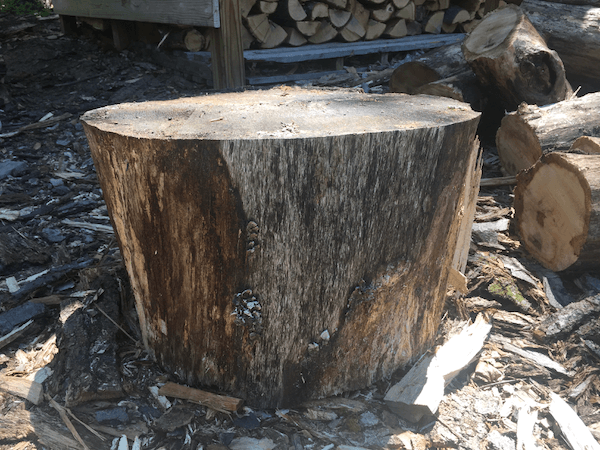
Second, a splitting block keeps your axe from getting chipped when it hits the dirt.
A good splitting axe has a sharp edge and they perform better when you can keep the edge in good condition.
A great tip to improve a standard splitting block is to screw an old tire to the top of the block.
Just take a couple of outdoor screws and screw the inner rim to the top of the block.
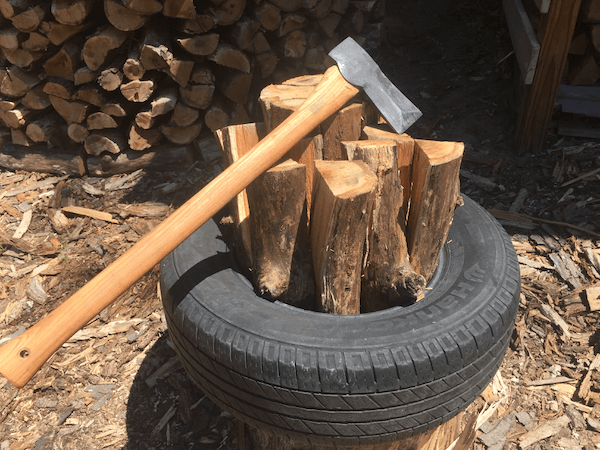
The tire holds the split wood upright so you don't have to reposition the wood after every swing.
It also provides a rubber bumper to protect you and your axe if you happen to miss the wood or if your axe glances off the wood.
Hydraulic Firewood Splitter
A hydraulic log splitter is by far the most effective firewood splitter if you have a lot of wood to process.
Hydraulic splitters are great because they basically do all the hard work for you.
The only thing you need to do is lift the log on to the splitter.
If the log is too big to lift, a good splitter will have a vertical splitting option (usually is just a pin you can pull that allows you to put the splitter in a vertical position) which allows you to split the wood without picking it up.
The downfall to a hydraulic splitter is the initial upfront cost.
Typically a hydraulic splitter is available in several different "tons."
The lowest is usually a 25 or 27 ton splitter.
For the average homeowner, these models offer more than enough power to split firewood for your home.
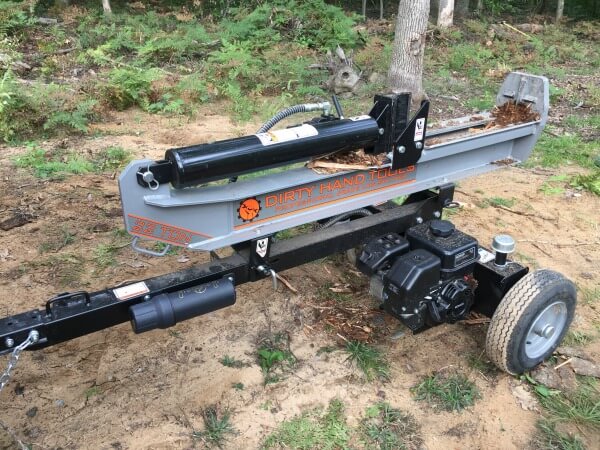
I really like the Dirty Hand Tools hydraulic log splitter.
For around $1000 it's competitively priced and it works great!
Firewood Splitter - Overall
Using a good firewood splitter is a game changer when it comes to heating with firewood.
By using a modern, high quality tool it can make a daunting task more enjoyable and effective, leaving you more time to relax, instead of chopping wood.

About the Author
Obsessed with firewood, Nick is behind over 350+ of Firewood For Life's articles, as well as countless reviews, guides and YouTube videos to help readers like you reduce heating costs and create the perfect fire.


